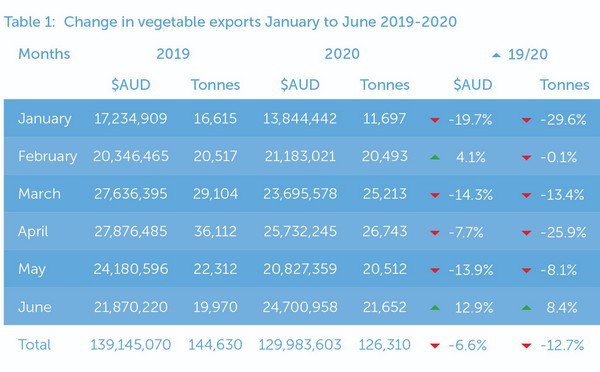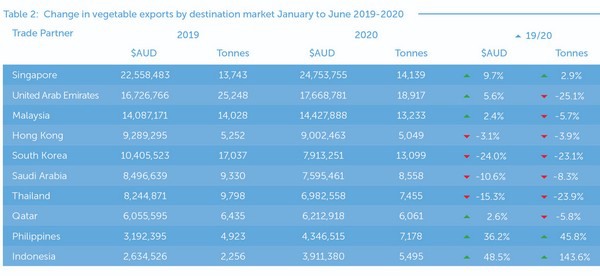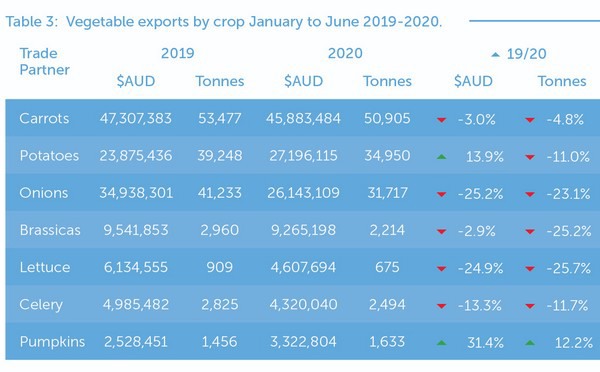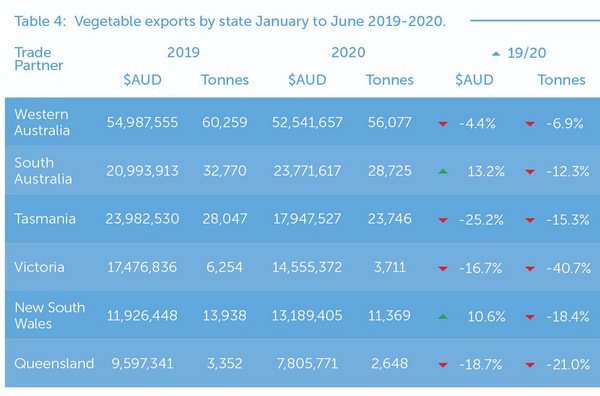Australia’s export of fresh vegetables saw a drop of 6.6 per cent for the first half of 2020, with the industry achieving export value of $130 million and 126,000 tonnes during a challenging period for exporters. With market closures, the food service sector grinding to a halt, supply chain disruptions and freight services being heavily impacted by COVID-19, vegetable exporters’ perseverance was rewarded with international trade figures up 12.9 per cent in the month of June 2020. AUSVEG International Trade Specialist Andrea Lin reports.
Following a difficult start to the year with tough environmental conditions – bushfires and drought – exporters have managed to keep international trade going through the COVID-19 pandemic. While some vegetable export crops have faced challenges during the first half of the year, the vegetable export supply chain is resilient, with over 126,000 tonnes of fresh vegetables shipped to international markets during the COVID-19 pandemic.
Exporters continue to deal with challenges in freight and logistics, particularly with securing air freight, which was reduced by as much as 90 per cent earlier in 2020. However, with support from the Federal Government’s International Freight Assistance Mechanism, there is more capacity in the air freight network to support exporters. At the time of writing, there were approximately 1,400 international flights out of Australia carrying freight per month, down from 9,000 in pre-COVID times.
The Australian Dollar (AUD) appreciated to over US$0.72 for the first time in 15 months in August. Continued strengthening of the AUD may impact competitiveness of Australia’s fresh vegetable exports in international markets.
Exports from January to June 2020
In the first half of 2020, total vegetable exports declined slightly compared to the same period in 2019. Based on data from the Global Trade Atlas, there was a slight dip of 6.6 per cent in vegetable export value, from $139.1 million to $129.9 million.
Total vegetable export volume declined by 12.7 per cent from 144,630 tonnes to 126,310 tonnes over the same period. The month of June 2020 saw an upturn in vegetable trade, with export value increasing by 12.9 per cent to $24.7 million and volume increasing 8.4 per cent to 21,652 tonnes (refer to Table 1).

Table 1: Change in vegetable exports January to June 2019-2020.
Click here to enlarge
Exports by destination market
Singapore remained the top export destination for Australian vegetable exports, with an increase in value in the first half of 2020 by 9.7 per cent (from $22.5 million to $24.7 million); export volume was up by 2.9 per cent from 13,743 tonnes to 14,139 tonnes.
The United Arab Emirates (UAE) rose 5.6 per cent in value but experienced a decline of 25 per cent in volume. Malaysia saw a similar trend, with a rise in export value of 2.4 per cent and a decline of 5.7 per cent in volume. South Korea experienced the largest decline in trade of the top export markets, with an average drop of 24 per cent in both value and volume (refer to Table 2).

Table 2: Change in vegetable exports by destination market January to June 2019-2020.
Click here to enlarge
Exports by crop
For the first half of 2020, root vegetables such as carrots, potatoes and onions continued to ship significant export volumes. Notably, potato export value has increased from $23.8 million to $27.2 million, nearly 14 per cent up on 2019.
Pumpkin is the only vegetable that has recorded an increase in both export value and volume. Pumpkin exports grew by 31.4 per cent, from $2.5 million to $3.3 million and an extra 170 tonnes in volume from 1,456 tonnes in 2019 to 1,633 tonnes in 2020 (refer to Table 3).
The figures in Table 3 outline the total exports for the January to June 2020 period, but do not highlight monthly fluctuations for different crops exports. Over the course of these six months, perishable air freighted products saw a drop in exports on a month to month basis, albeit with some exceptions for certain crops into specific markets. Generally, sea freighted hard vegetable products performed better than the perishable vegetable exports; however, carrots, potatoes and onions also experienced fluctuating trade from month to month.

Table 3: Vegetable exports by crop January to June 2019-2020.
Click to enlarge
Exports by state
While the performance of Australian vegetable exports has been more consistent and better than expected due to COVID-19 disruptions, exporters from different Australian states have fared differently during 2020. Western Australia remained the strongest fresh vegetable export state, with a dip of 4.4 per cent in value and around 4,000 tonnes compared to 2019. Victoria had a significant drop in export volume of 2,543 tonnes or 41 per cent, seeing exports fall from 6,254 tonnes to 3,711 tonnes. South Australia and New South Wales both saw increases in export value and a decrease in export volume, on the back of potato exports (refer to Table 4).

Table 4: Vegetable exports by state January to June 2019-2020.
Click here to enlarge
Source: Ausveg
